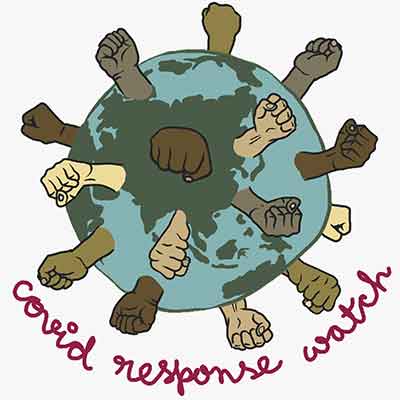COVID-19 patients dying on the streets gasping for oxygen. Hundreds of wailing, desperate folks searching for hospital beds to access treatment. Even the dead denied dignified funerals, their bodies dumped unceremoniously in the rivers of India.
Much has been written about the reasons for the Indian government’s abysmal failure to prepare for the devastating surge in COVID-19 cases in India since early April this year.
Among other things hubris, incompetence, intolerance of opposing views and the penchant of Indian PM Narendra Modi to put his own publicity above all national priorities have been blamed. To deflect criticism of the government, its supporters themselves have identified the ‘system’–presumably the country’s rickety healthcare system–as being at the heart of the problem.
Yes, all these factors have indeed played a role in COVID-19 wreaking far greater havoc than it should have. And yet, none of them capture the real story of why a country which is the world’s 5th largest economy, has the second largest army and is a space, nuclear and pharma power to boot, provide something as basic as oxygen to its choking citizens or firewood to cremate its dead ones?
The answer in a nutshell, lies in the fact that the modern Indian Republic–built as it is on the edifice of the British colonial state–is designed to work only on behalf of a tiny minority of Indians, leaving the vast majority to fend for themselves. While elite control of political and administrative power is not unique to India–here the separation between the rulers and the ruled is magnified immensely by several special factors.
One is of course the apartheid—like caste system, which results in a lack of empathy of any kind within Indian society to a point where a very vast section of the population is not considered to be even human at all.
A decade ago Dr Binayak Sen, the well-known doctor persecuted by the Chhattisgarh government for his human rights activism, had called widespread malnutrition in India nothing less than a ‘genocide’. In other words, he implied that large sections of Indian citizens were being deliberately condemned to early deaths by those in power in the country.
At that time even, many of his supporters thought the good doctor was perhaps indulging in some hyperbole by using the ‘G’ word for what was usually blamed on inefficiencies of the Indian state machinery. The standard explanations for the abysmal health of much of the Indian population and their lack of access to healthcare facilities have been lack of national resources combined with bureaucratic sloth and political indifference.
Dr Sen’s argument was that over 33 percent of India’s adult population had a Body Mass Index below 18.5, indicating severe malnutrition. Further, 47% of Indian children under the age of five are malnourished by weight-for-age criteria, while 26% of newborn babies are low birth weight.
Dr Sen’s rationale for using the term genocide was that such malnutrition was not evenly distributed across the Indian population but mostly concentrated among the scheduled tribes and scheduled castes. Together, these two categories of Indian citizens constitute over 29 percent of the population but account for more than half of malnutrition cases. Not surprisingly, they also bear a bulk of the country’s disease burden, whether it be tuberculosis and malaria, or infant mortality due to diarrhoea and pneumonia.
Malnutrition and disease burden levels among poorer sections of the Other Backward Castes, who comprise another 41 percent of the Indian population is not very far behind either. India ranked 94 among 107 countries in the Global Hunger Index 2020, with only 13 countries faring worse, including countries Rwanda, Nigeria, Afghanistan, Liberia, Mozambique and Chad among others.
A second systemic reason for the catastrophic impact of COVID-19 on India is the phenomenal concentration of wealth in the country. The top 10% of the Indian population holds 77% of the total national wealth, in a nation that is also home to the largest number of people in absolute poverty in the world.
Much of this wealth of the Indian elite is cornered through crony capitalism and inheritance, with every political party in power designing policies solely for their sake, with little concern for the welfare of a majority of Indians. For example, India’s public expenditure on health as a percentage of GDP for 2017-18 was a mere 1.28 of GDP, one of the lowest in the world, a shameful record steadily maintained since independence from British rule seven decades ago.
The resulting poor quality of public health facilities combined with the fact that over 75 percent of all healthcare is in the private sector means India also has one of the highest out-of-pocket expenditure on health globally- at 62.6 percent. For most Indians decent healthcare is simply unaffordable and spending on health is one of the main reasons for many falling deep into debt. Health concerns account for over 20% of all suicides in India.
In other words, what is clear is that the failure of the ‘system’ is not due to some kind of ‘laziness’ or ‘inefficiency’ on part of those who have controlled the levers of power in India all these years. Instead, the Indian social and economic system is deliberately meant to make a bulk of Indian citizens suffer and die needlessly–as it only through extreme cruelty that it can consolidate and perpetuate itself.
Without policies that overthrow caste hierarchies and drastically redistribute wealth, for most Indian citizens hoping for better healthcare of any kind is likely to be futile. The real lesson from the COVID-19 crisis is that the choice is today between their own survival or that of a system that is both colonial and racist at its core.
Satya Sagar is a journalist who can be reached at [email protected]

